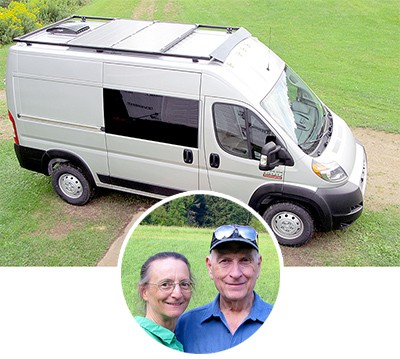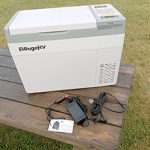
When van camping, have you ever wished that you could run a TV, computer, game console or AC unit while in remote areas that have no convenient source of power? It’s lonely and hot out there in the boondocks! After a lot of research, I’ve learned the “ins and outs” of modern inverters. In this post, I’ll share what I’ve learned so that you can decide if an inverter is the right choice for you.
What’s an inverter? In simple terms, the inverter does two essential things: First, it changes power from the van’s existing DC power system from DC (Direct Current) to AC (Alternating Current). Secondly, the inverter increases the voltage from 12 volts to a higher voltage – typically 120 volts AC in North America.
So basically, an inverter is an electronic device that could make your van camping experience a whole lot more enjoyable. Inverters change the power in your van into the type of power that is in your home.
Why would you want to do that?
Have you ever wanted to use the modern conveniences found in your home while on the road? Inverters provide a source of power similar to that found in your home. Inverters allow you to use items designed for home use, while you are traveling.
You’ve noticed that the plugs on your home electronics do not match the outlets in your van and vice versa. That’s because the electrical system in your van and the electrical system in your house serve different types of needs.
The electrical system in your van is a simple, “low-voltage” “direct-current” system suitable for mobile use. The electrical system in your home is a more complex “alternating-current” system that serves stationary applications such as homes and industry.
While these two types of systems are incompatible, you can convert one to the other easily. That’s the job of an “inverter,” it takes low-voltage power from your van and “inverts” it to higher-voltage alternating current. An inverter gives you the freedom to operate home devices in your van.
Sounds complicated, right? Nope, we’ve got you covered. Just follow along, and you’ll soon have an understanding of how an inverter works and why you might need one in your van.
An un-converted van, purchased from the showroom floor, typically includes ONLY a direct current power system, made up of starting, generation, lighting, entertainment and powertrain control sub-systems. This system includes the vehicle battery and it’s typically a 12 volt, direct current system.
You will commonly find direct current systems in lower voltage, portable applications such as automobiles, camping trailers, RVs and boats. You’re probably wondering, “What is a Direct Current system, and how does it operate?” Direct current flows through your van’s wiring and loads in one direction only.
Many modern consumer and electronic devices may be powered directly from your van’s existing 12 volt DC power system. You may find that other electronics, such as a TV, microwave or fridge, require a different type of power, “120 volts AC” for proper operation.
If you could change your van’s 12 Volts DC to “120 Volts 60 Hz AC,” you would be able to operate common electrical household devices in your van. An inverter performs this task for you, allowing you to use your favorite consumer gadgets while “getting away from it all!”
Regardless whether you are a recreational vanner, boondocker, full-time vanner or a prepper getting ready to bug out, knowing the types of inverters and the pitfalls of inverter selection will help you select the proper inverter for your lifestyle.
So let’s get started!
Why would I want an inverter in my van?
As mentioned above, many modern electronics may be powered directly from your van’s existing power. Buying direct-powered electronics is the best path to follow when obtaining new electrical or electronic items for use in your van.
Many types of devices are available in “dual-power” or dc-power-only versions. These devices may be powered from the 12 volt DC power already in your van. They may cost more, but by powering them from DC, the load on your inverter will be smaller.
Select items that you can power directly from the vehicle’s power supply; you will be able to utilize a smaller, less expensive inverter.
Getting back to why you may want an inverter:
You may want to install items in your van such as a TV, DVD player, fridge, CPAP or oxygen machine that are not available in a DC-powered version. You may also find that the DC-powered version is cost-prohibitive. Perhaps your laptop does not run on 12 volts DC or there is no 12 V DC power cable available.
You now have to modify or “invert” your van’s 12 volt DC power into power, which is compatible with your consumer devices. If you live in North America, most likely, these devices have been designed to be powered by “120 volts 60 Hz AC” power.
How ReVOLTing! You may be asking, what’s all this “volts” stuff? A volt is simply a measurement of electrical force, similar to pressure in a water system. Lower volts = less force to push electricity through wires and loads.
Have you ever pressed your finger across the terminals of a 9-volt transistor battery? Chances are you did not feel a thing. Did you ever accidentally put your fingers across 120 volts? Ouch + Danger! Higher volts = higher “pressure” = higher danger.
Back to your van: it probably has a 12 volt DC (Direct Current) power system.
Direct current has a cousin you may have heard of called alternating current.
Alternating current (AC) flows through wiring (and loads) first in one direction, then reverses and flows the opposite direction. Yes, this way →, then this way ←. In North America, the current typically alternates or changes direction, 120 times per second. One pair of alternations is called a “cycle,” which may be referred more commonly to as “Hertz” or “Hz.”
Other Posts of Interest
- Camper Van Insurance: How Much Should You Spend?
- Can You Use A Cargo Box On A Camper Van Roof?
- Wild Van Camping in the PA Wilds – Hammersley Wild Area
Why is there an alternating current? Why should I be concerned with this?
Alternating current allows the cheapest practical method of long-distance power transmission. Utilizing alternating current allows your power company to efficiently move power hundreds of miles from the generating station to your home.
In other words, the outlets in your home provide alternating current (AC) because AC is the most effective way to get power to your home.
In North America, the outlets in our homes normally supply electricity at 120 Volts AC 60 Hz. Therefore, most consumer electronics and products are designed for home use and thus operate on 120 V AC 60 Hz.
However, what’s good for the home is not best for your van. Unfortunately, the typical consumer devices found in your home cannot operate directly from the DC system in your van.
Now, you are beginning to see the purpose of an inverter.
Inverters vs. Nuclear Physics – Which Is Less Confusing?
At the start of this post, I stated that an inverter does two essential things:
- First, it changes power from the van’s existing DC power system from DC (Direct Current) to AC (Alternating Current).
- Secondly, the inverter increases the voltage from 12 volts to a higher voltage – typically 120 volts AC in North America.
So, the inverter changes this straight line figure 1-A into this wavy line figure 1-B.

For most of you, buying an inverter with an input rating of 12 volts DC and an output rating of 120 volts 60 Hz AC will allow you to operate your favorite electronics in your van.
Have you ever heard of anyone ruining their TV when powering it with an inverter? How do I avoid this?
It all boils down to proper inverter selection coupled with appropriate load selection.
Some inverters – notably the less expensive ones – produce an output, which varies quite a bit in quality from the electricity found in your home. The electricity found in your home is high quality, sine-wave power that is reasonably constant voltage and has reasonably low electrical “noise.” A voltage graph of power available at outlets in your home would look similar to figure 1-B above.
Notice how the voltage changes in a controlled, smooth manner, how “clean” and repetitive it looks. However, if you were to graph the output of a low-end (in this case, “cigarette-lighter”) inverter, it might look like the 2-A figure below.

Notice the difference in shape and the irregularity of the pattern. That square stuff and irregularity can cause a TV to fail. Improper voltage waveform and heat killed it. Heat is the enemy of all electrical and electronic devices and will eventually kill them.
You’re probably wondering, “How can I protect my electronics?”
A comparison of low-cost vs. modified-sine-wave vs. sine-wave inverters
Unsurprisingly, this will also be a comparison of inverter pricing:
The low-end inverters will provide a “square-wave” or SW output. Inverters having a square-wave output are the simplest, easiest and cheapest to build. They also are most likely to damage electronics, and for that reason, you should probably avoid them.
Poor-quality power supplied by a square-wave inverter is shown above in figure 2-B.
Next in quality and pricing are the modified sine wave inverters, shown below in figure 3-A. You can use them to operate larger loads, motor-driven loads. This type of inverter is usually mid-priced and mid-quality.
Highest in quality are true-sine-wave inverters. These inverters are capable of running all loads, from motor-driven ACs through sensitive electronics. They will also be the most expensive type. Their voltage waveform output looks like the above figure 1-B.
A comparison of true-sine-wave inverter output voltage (shown in red below) versus modified-sine-wave inverter output (shown in blue below) would look like figure 3-B.

In the graph above, contrast the desired red wave with the more distorted blue wave. It’s the differences between the two that will cause your electronic devices to internally generate excess voltages and heat that may eventually destroy the device.
Note also that the red waveform is not a perfect sine wave, but its relatively smooth contours will approximate the power found in your home.
Are you wondering how this relates to your TV and medical devices? Keep reading!
A word about loads
Some loads present greater demands on their supply of power – motors in particular. Compared to the commercial power supply at your home, an inverter may not be able to maintain the proper “phase” relationship between voltage and current, especially with larger loads that have a “reactive” component, such as motors.
During startup, motors present a larger load than when running at full speed.
Items such as a fridge, oxygen machine or CPAP machine may draw a heavy load, not only when initially starting, but also whenever the motor energizes. This heavy load may cause your inverter to trip out or simply shut down — not a good thing with a full fridge.
For this reason, you would want to ensure that the load is compatible with the output of the inverter you select. If you are planning to operate motorized equipment such as a fan, medical device or small air conditioner, check with the manufacturer. Manufacturers of specialty equipment may recommend a specific inverter for use with their equipment.
To learn more about selecting an inverter for your van build, read our post here.
What precautions should I exercise when powering my equipment from an inverter?
You should power sensitive electronics such as TVs, satellite systems and laptops with a higher quality, true-sine-wave inverter.
Heavy loads such as refrigerators, fans or other motor-driven loads may be driven from a modified-sine-wave inverter or a true-sine-wave inverter. Still, here you may wish to carefully check the manufacturer’s recommendations for both the inverter and prospective loads. Online reviews may also help to select a proper match.
What loads should I AVOID running on my inverter?
- Electric heaters are inefficient. There are better ways to heat your van.
- Toasters and hotplates/electric cooktops are inefficient as well, although you may get away with it due to the low amount of use. The campfire or gas cook stove makes more sense.
- AC. Yes, it can make camping more enjoyable. In some places, camping is unbearable without AC. Other options, such as the AC in the van dash, or open windows with a fan make more sense. If you absolutely have to run AC from the inverter, make sure that the inverter and AC unit are compatible.
- Other heavy motor-operated equipment
- Lights – power these from the DC supply instead
What you may find is that it may be best to have two separate inverters. A larger modified-sine-wave one if you will have lots of heavy motor-driven loads such as a fridge and AC, augmented with a smaller true-sine-wave one to power your sensitive electronics.
If your circumstances indicate only a single inverter, spring for a true-sine-wave one, a refrigerator may run from a true-sine-wave, but running your medical equipment from a modified-sine-wave may not be wise.
What are some safety precautions to observe when using an inverter in my van?
An inverter puts out the same type of power that is available at an outlet in your home. It makes sense, doesn’t it? The TV that you moved from your home to your van requires the same power no matter where it operates.
Just because the inverter is powered from your van’s 12 volt battery, don’t make the mistake of thinking it’s just as safe as the 12 volt battery. It isn’t safe – it will kill you if improperly used, just as the electricity available at the outlets in your home will kill you if improperly used. An inverter is only as safe as you make it. Observe safety precautions!
What is an overcurrent device?
The function of the overcurrent device is to help prevent equipment damage and help prevent fires. Some inverters may come with a built-in overcurrent device – a circuit breaker or fuse. If your inverter has an internal overcurrent device, it may help prevent damage to the inverter in case of accidental overload.
Nevertheless, this does not relieve you of the responsibility of installing overcurrent protection near the battery supply, to protect the wiring between the battery and inverter. Always install overcurrent protection near the battery to protect the wiring. Smokey Bear will thank you. Your insurance company will thank you.
Can I use the inverter while driving my van?
Yes, absolutely!
As you can see, inverters have the power to make your van camping trips a little more comfortable. I hope this post assists you in understanding what an inverter is and how you can utilize one in your van build.
Van Camping Life Disclaimer: We are not electricians; we just van camp as a pastime/hobby. While writing this post, we put hours of time and effort into researching this topic to provide you with the most comprehensive information that we could give you.
All aspects of working with electricity are dangerous and can have severe consequences if not done properly.
Research any electrical projects thoroughly, get additional help from a licensed electrician or have a licensed electrician do your complete electrical project.






